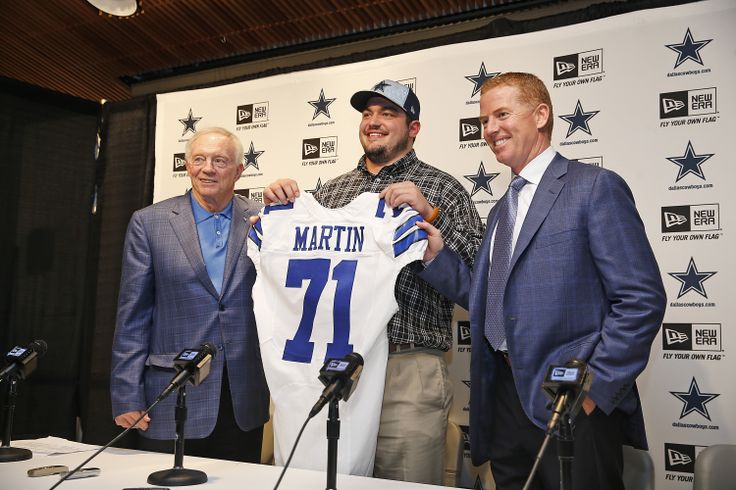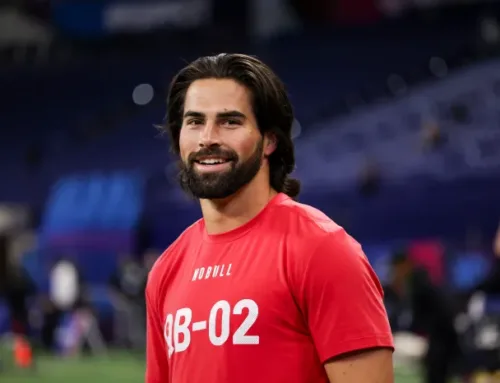In this most recent NFL draft, we saw the Cleveland Browns use a second round pick on 2014 signee Deshone Kizer, who was roughly a top 250 recruit. Compared to other Notre Dame draft picks over the last decade, Kizer did pretty well for himself – top 250 players don’t have a great hit rate in the draft. Does his selection say more about the Notre Dame coaching staff or the recruiting services? For that matter, is the draft a better barometer to evaluate the recruiting rankings, or the coaching staff? The answer to both questions is probably, well, both, as Deion told Jerry Jones way back when. Nonetheless, digging into the recent data about the Irish definitely yields some interesting stuff. So, grab your shovels, folks.
The Setup & the Data
UPDATE: Unfortunately, it turns out that the original analytics in this post were based on an incomplete data set – I didn’t realize that the 247 historical recruiting page I used was only showing players with a 0.8600 score or better (mid-level three-star). Further, scores were unavailable for most of the 2001-2002 classes, so I cut them and the 2006 draft class out of the analysis. I completed the dataset with all players (sans specialists, since they skew things) in all classes from 2003 forward and re-ran the analysis; while the top four categories remained largely unchanged, the “Below Top 250” category was dramatically affected. Which isn’t surprising given that most of the players left out of the original dataset were lower-ranked players. I apologize for the oversight in the data, that shouldn’t happen. Below this point, this post is substantially revised from the original published version.
I looked at Notre Dame draft picks starting in 2007, which included players from the 2003 recruiting class, because the recruiting data gets pretty sparse before then. I also left out everything from the 2014 recruiting class forward as being too young to contribute meaningfully to the analysis. That leaves out Kizer, but given that we’re talking about current academic juniors and younger I think it’s fair. Players who signed with Notre Dame but finished elsewhere are included in the analysis. I broke the players into five categories:
- Five-star/Top 30 players: Not all of these were technically five-star players because of variances in the ratings from year to year, but they were all creme de la creme recruits.
- Top 30-100 players: These are high-level four stars who you typically would expect to be lead contributors.
- Top 100-150: These are mid-level four stars who look like possible starters.
- Top 150-250: These are mid- to low-level four stars who you think have potential.
- Below Top 250: Often seen (by fans) as program guys or developmental projects, these are the three-stars and below.
Here’s how the draft pick rate and top-two round rate work out by recruiting rank level:
| Category | Number | Drafted | 1st/2nd Rd |
| Five-star/Top 30 | 16 | 56% | 44% |
| Top 30-100 | 33 | 27% | 0% |
| Top 100-150 | 22 | 45% | 14% |
| Top 150-250 | 39 | 15% | 10% |
| Below Top 250 | 137 | 13% | 4% |
Drawing Unwarranted Conclusions About Notre Dame Draft Picks
The headliner is that five-stars generally do turn out relatively well. That’s a headline of similar shock value as “Dog Bites Man,” perhaps, but at the same time it’s good to have confirmation of what intuitively feels correct. We had 16 top 30 signees between 2003 and 2013, which counts Stephon Tuitt and Kyle Rudolph, who were just barely below official five-star status, as well as Gunner Kiel, Aaron Lynch and Max Redfield, who obviously didn’t finish at Notre Dame. Nine of those 16 went on to be drafted, and seven went in the first two rounds: Michael Floyd (#13 overall), Jaylon Smith (#34), Manti Te’o (#38), Kyle Rudolph (#43), Stephon Tuitt (#46), Jimmy Clausen (#48), and Victor Abiamiri (#57). Lynch and Sam Young are the outliers there; Lynch went in the fifth round and Young went in the sixth. Redfield, Ishaq Williams, Dayne Crist, Gunner Kiel, James Aldridge, Duval Kamara, and Rhema McKnight are the undrafted top 30 recruits, if you’re curious. My guess is that the kids in this group are so supremely talented that their potential is obvious, hence the five-star status. There’s no magic algorithm to it, there’s just seeing a kid whose athleticism is not just head and shoulders but hips, knees, and feet above everyone else his age and saying, “Hey, this kid could be good!”
The dropoff to the next group is shockingly steep, which to me is the big story that came out of this analysis. Only seven of our 33 top 30-100 signees were drafted, which seems strongly counter-intuitive. Even more surprisingly, none of those seven went in the first two rounds of the draft. Keep in mind that this data spans three coaching staffs, two of which have proven reasonably good at putting kids into the league. So what gives? Well, there really isn’t any common thread through them. One, Greg Bryant, met a tragically early demise, gunned down by a random club-goer in 2016 before the draft was even a possibility for him. Some were good college players but not quite good enough for the pros, like Ethan Johnson, Vontez Duff, and Matt Hegarty. Some were good enough for the pros but couldn’t get their heads on straight long enough to be drafted, like Cierre Wood and Davaris Daniels. And then of course there were garden-variety busts, as well. It’s kind of tough to figure out why this group in particular did so poorly, but if it’s anything more than a statistical blip my guess is that it tends to be populated by guys who look phenomenal in camp settings but then aren’t always as adept when the lights go on. It could also be that some of them, given the early-career adulation, are more prone to fold when things don’t go their way at the next level.
Another explanation is that, quite simply, Charlie Weis and Ty Willingham stunk at developing talent. Six of the seven draft picks in this recruiting category played at least two years under Kelly, with 2007 draftee Derek Landri being the lone Weisingham product. Sometimes, the simplest explanation is indeed the best.
Interestingly, the next group, top 100-150 guys, fared significantly better. Ten of the 23 players in this group were drafted, doubling the rate of the high-four-star group. The quality here was very good, too, as among those ten draftees were first-rounders Brady Quinn and Ronnie Stanley and second-rounder Golden Tate, who also won the Biletnikoff Award. I would also tab 18 of these 23 kids as meaningful contributors, even if just as depth guys, which is well above the rate of the group above them (78% to 64%). Granted, that metric is a lot fuzzier than drafted or not drafted, but still, it seems that this group has been much more productive despite its lower rankings. Hmm. Possibly this group is full of guys who are clearly talented, but not so much of a workout warrior as to invite overrating.
We had 39 top 150-250 guys and only six were drafted, but again the quality was good – first rounder Will Fuller and second-rounders Trevor Laws and Anthony Fasano. I don’t think there’s a whole lot to analyze here; I think one in every seven of these guys making it into the draft feels about right. The obvious natural talent level drops off, and the hit rate drops off accordingly.
The final group, though, shows an interesting blip in the data. We had 137 guys outside the top 250 and 16 of them were drafted; their draft rate was essentially the same as the low four-star group despite being ranked substantially lower in most cases. In addition, the quality in those 16 picks was phenomenal: three first-round picks and Pro Bowl players in Zack Martin, Harrison Smith, and Tyler Eifert, who also won the Mackey Award, and two second-rounders in Nick Martin and John Carlson.
Why on earth might the lowest-ranked group be more proficient than expected at turning out draft picks? I think the most likely reason is that these are guys who coaching staffs have evaluated through their own channels but are off the radars of the recruiting services. As fans we tend to think that the services know everything about everyone, especially as their coverage expands, but there are always guys they miss, or are late bloomers, are a better fit for a particular program than their recruiting rankings would suggest. One might be prompted to keep this in mind the next time one sees a commitment from a three-star player.
And One or Two Warranted Conclusions
There’s no question that the recruiting services do well at evaluating the 99th percentile performers, but at the same time there are so many variables that the rankings aren’t the be-all, end-all. The best strategy, not surprisingly, seems to be to amass a good number of talented kids and projects and nab a couple of potential difference makers when you can. And then hope that your staff has some idea how to develop them… I’ll be very interested to track these numbers over the next few years, as the Irish have signed some talent that should in theory turn out some pretty decent pro prospects. Ever onward.





Great breakdown – I like these, especially when you are able to go back 10 years and have a meaningful sample size. This also fits with some of the breakdowns from this past year – notably, that ND needs to focus more on recruiting 5*s (and not just the high 4*s) as those guys tend to be difference makers and more of a sure thing (with the occasional blip).
Thanks!
Great work. I love these statistical analyses. It’d be great if we could compare the results over time, but it’s such a small sample size that it’s hard to compare (say) last year to this year’s draft.
Thanks man. Yeah, with roster turnover in college it’s really hard to get anything meaningful from anything less than, say, a five-year window. Like we had two players drafted this past year, but that was in part because we had a lot of young guys. Certainly in part because the team underperformed and a number of individuals underperformed, but also because of the age question.
Also, with recruiting in particular there’s almost no data available before the late 90’s. It’s really 2002-ish when things started to pick up, so that kind of naturally limits the data set. I did like that this went across three coaching staffs, and two that had put some guys in the pros – Weis did OK, and Kelly has done very well. We won’t talk about Ty.
This is great. My guess for the unexpected hit rates is simply sample size. When you look at the recruit ranking vs draft position for all of CFB, it tends to be more in line with basically every tier getting drafted less than the one above it (even within 5 stars, there’s a difference between top 10 and 11-30). It also wouldn’t surprise me that as recruiting has seriously blown up as an industry, that draft picks fall even more in line with ‘crootin’ rankings.
This is cool, especially since I’m kind of obsessed with the draft and fairly familiar with recruiting.
The one variable that’s tough to account for is the way recruits’ rankings are oriented mostly around their fit for the college game, which is a bit different from the pro game. That said, you’re not really breaking things out round-by-round so the implications aren’t that big. Anyway, a kid like Ben Boulware comes to mind — #78 in the ESPN 300, productive starter for a two-time top-two team, goes undrafted. What gives?
Only 176 players in 13 recruiting classes? What am i missing here?
Because we had such integriTY
Hmm… Good point… Upon further review, it would seem that the list of recruits pulled from 247 is not exhaustive. It has, in fact 247 recruits listed from 2001 to 2018, which seems both small and suspiciously coincidental. I’ll see what I can do to expand the data set here, going to take some more legwork. I think the missing guys are probably going to be mostly lower-rated guys.
See the update above – I fixed the data. I will now go off to the corner and self-administer 40 lashes.
Thanks Brendan! The bust rate of teh 30-100s is still surprising, but considering the small sample size i’d bet within the next 10 years that category will rise to its expected relative position.
I think it’s most likely more of a developmental thing. Charlie did OK at getting guys drafted, not great, but there were just so many busts with him. Look at Sam Young – five star OL who disappointed by going in the sixth round, but ten years later he’s still in the league. He must have some ability, right? If he had a coach like Hiestand back then I’m guessing he would’ve been an early round selection.